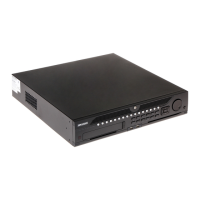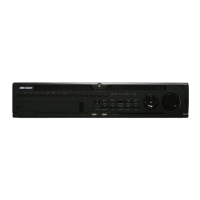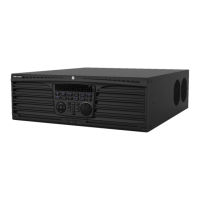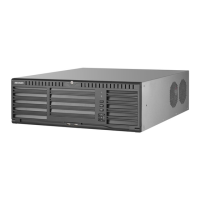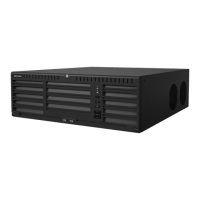Do you have a question about the HIKVISION DS-9632NI-I8 and is the answer not in the manual?
| Product color | Black |
|---|---|
| Rack capacity | 2U |
| Rack mounting | Yes |
| Operating temperature (T-T) | -10 - 55 °C |
| Operating relative humidity (H-H) | 10 - 90 % |
| AC input voltage | 100 - 240 V |
| AC input frequency | 50 - 60 Hz |
| Power consumption (max) | 30 W |
| Display modes | Live view |
| Input bandwidth | 320 Mbit/s |
| Output bandwidth | 256 Mbit/s |
| Maximum frame rate | 60 fps |
| Maximum resolution | 3840 x 2160 pixels |
| Alarm input channels | 16 |
| Video input channels | 32 channels |
| Alarm output channels | 4 |
| Video formats supported | H.264, H.265, MPEG4 |
| Still image resolution(s) | 3840 x 2160, 2560 x 1440, 1920 x 1080, 1600 x 1200, 1280 x 1024, 1280 x 720, 1024 x 768 |
| Resolution at capture speed | 1280x720@60fps, 1920x1080@60fps, 3840x2160@30fps |
| USB 2.0 ports quantity | 2 |
| Ethernet LAN data rates | 10, 100, 1000 Mbit/s |
| USB 3.2 Gen 1 (3.1 Gen 1) Type-A ports quantity | 1 |
| RAID levels | 0, 1, 5, 6, 10 |
| HDD capacity | 0 GB |
| HDD interface | Serial ATA |
| Maximum storage capacity | 48 TB |
| Number of HDDs installed | 0 |
| Number of HDDs supported | 8 |
| Wi-Fi | No |
| Depth | 445 mm |
|---|---|
| Width | 470 mm |
| Height | 90 mm |
| Weight | 10000 g |
Describes the front panel layout and components of the DS-9600NI Series NVR.
Details how to operate the NVR using the included IR remote control, including pairing.
Explains how to use a USB mouse for NVR operations and describes mouse control functions.
Describes the soft keyboard interface and its button icons for inputting text.
Details the rear panel interfaces and connectors of various NVR series.
Covers starting up, shutting down, activating the NVR, and login procedures.
Guides through the initial setup wizard for basic NVR configuration.
Details the process of activating, adding, and connecting IP cameras to the NVR.
Provides an overview of the live view function and describes live view icons.
Explains various operations and functions available in live view mode.
Details how to customize live view settings like output interface and dwell time.
Explains channel-zero encoding for reducing bandwidth in remote views.
Details the procedure to set PTZ parameters before controlling the PTZ camera.
Covers customizing and calling presets, patrols, and patterns for PTZ cameras.
Describes how to enter and use the PTZ control panel.
Details how to define image quality parameters like stream type and resolution.
Explains how to set the recording and capture schedule for cameras.
Guides on setting motion detection parameters and scheduling records.
Details how to configure alarm-triggered recording or capture.
Explains how to configure event-triggered recording for VCA events.
Covers setting parameters for manual recording and continuous capture.
Details how to configure record or capture schedules for holidays.
Explains enabling redundant recording and capture for data safety.
Describes how to group HDDs and save files in specific HDD groups.
Covers locking recording files or setting HDD property to Read-only.
Details various methods for playing back recorded video files.
Covers additional playback features like frame-by-frame, thumbnails, and digital zoom.
Provides methods for backing up record files using various devices.
Details management of backup devices like USB drives and eSATA HDDs.
Explains setting up a hot spare device for system reliability.
Guides on setting up motion detection parameters and schedules.
Details handling actions for external sensor alarms.
Covers detecting video loss and configuring alarm response actions.
Explains how to detect video tampering and trigger alarms.
Describes handling actions for various system exceptions like HDD errors.
Details configuring alarm responses like event hints and full screen monitoring.
Explains how to manually trigger or clear alarm outputs.
Details configuring POS settings, protocols, and connection modes.
Explains how to assign POS machines to corresponding channels for overlay.
Covers setting POS privacy information to not display on the image.
Details setting POS alarm parameters to trigger actions.
Explains face detection function and its configuration.
Covers vehicle detection for traffic monitoring and license plate capture.
Details detecting people/vehicles crossing a virtual line.
Explains intrusion detection for objects in a pre-defined virtual region.
Covers detecting objects entering a pre-defined virtual region.
Details detecting objects exiting a pre-defined virtual region.
Explains detection of unattended objects in a pre-defined region.
Covers detecting objects removed from a pre-defined region.
Details detection of abnormal sounds in the surveillance scene.
Explains detection of changes in the surveillance environment.
Covers detection of image blur caused by lens defocus.
Explains PIR alarm triggered by intruder movement and heat detection.
Details searching for captured face pictures and related video files.
Explains searching for suspicious behavior based on VCA detection.
Covers searching captured vehicle plates and related information.
Details calculating people counts and generating reports.
Explains heat map function for analyzing visit times and dwell times.
Covers advanced search for thermal imaging detection results.
Details configuring general network settings like IP address and DNS.
Covers advanced network configurations like Hik-Connect, DDNS, NTP, SNMP.
Explains how to check real-time network traffic information.
Covers testing network delay, packet loss, and exporting network packets.
Details how to enable RAID and configure arrays using one-touch or manual methods.
Covers automatic and manual rebuilding of degraded arrays.
Explains the process of deleting an array and its data.
Details viewing firmware information and setting background task speed.
Covers the process of initializing newly installed HDDs before use.
Details adding and configuring NAS or IP SAN disks as network HDDs.
Explains how to configure and manage external eSATA devices.
Covers setting up HDD groups for managing storage.
Details configuring allocated storage quotas for each camera.
Explains cloning HDD data to an eSATA disk for data recovery.
Covers viewing the status of installed HDDs for maintenance.
Explains HDD detection functions like S.M.A.R.T. and Bad Sector Detection.
Details configuring alarms for HDD errors like Uninitialized or Abnormal status.
Covers configuring OSD settings like date/time and camera name.
Details configuring privacy mask zones to prevent viewing recorded areas.
Explains customizing image parameters like brightness and contrast.
Covers viewing system information through various tabs.
Details searching and exporting NVR operation, alarm, and exception logs.
Explains exporting and importing IP camera configuration files.
Covers exporting NVR configuration for backup and importing to multiple devices.
Details upgrading NVR firmware via local backup device or FTP server.
Explains how to restore factory default settings for the NVR.
Details configuring RS-232 serial port parameters for PC connection.
Covers configuring general settings like language, resolution, and time zone.
Explains how to configure Daylight Saving Time (DST) settings.
Details configuring additional settings like device name and auto logout.
Covers adding, deleting, and editing user accounts and permissions.
Provides detailed technical specifications for various NVR models.
Defines technical terms and acronyms used in the manual.
Offers solutions for common issues and problems with the NVR.
Lists changes and updates made in different firmware versions.
Provides lists of compatible Hikvision and third-party IP cameras.



